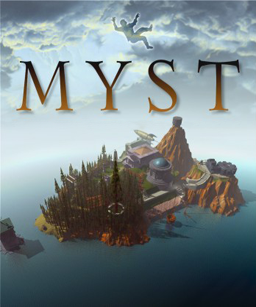
Myst is an adventure video game designed by Rand and Robyn Miller. It was developed by Cyan, Inc., published by Broderbund, and first released in 1993 for the Macintosh. In the game, the player travels via a special book to a mysterious island called Myst. The player interacts with objects and traverses the environment by clicking on pre-rendered imagery. Solving puzzles allows the player to travel to other worlds ("Ages"), which reveal the backstory of the game's characters and help the player make the choice of whom to aid.

Broderbund Software, Inc. was an American maker of video games, educational software, and productivity tools. Broderbund is best known for the 8-bit video game hits Choplifter, Lode Runner, Karateka, and Prince of Persia, as well as The Print Shop—originally for printing signs and banners on dot matrix printers—and the Myst and Carmen Sandiego games. The company was founded in Eugene, Oregon, and moved to San Rafael, California, then later to Novato, California. Brøderbund was purchased by SoftKey in 1998.
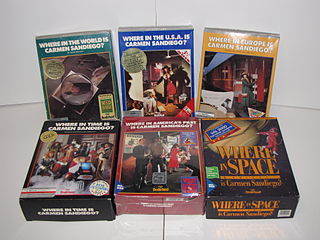
Carmen Sandiego is a series of American educational mystery video games that spawned an edutainment franchise of the same name. The game released in 1985, Where in the World Is Carmen Sandiego?, started off both the video game series and the franchise as a whole, which has continued up to the present day. Each game of the series has a particular theme and subject, where the player must use their knowledge to find Carmen Sandiego or any of her innumerable henchmen. This series was originally owned by Broderbund, but is now owned by Houghton Mifflin Harcourt. Since its initial release the series has won over 150 awards and accolades.

Diane Alexis Whipple was an American lacrosse player and college coach. She was killed in a dog attack in San Francisco on January 26, 2001. The dogs involved were two Presa Canarios. Paul Schneider, the dogs' owner, is a high-ranking member of the Aryan Brotherhood and is serving three life sentences in state prison. The dogs were looked after by Schneider's attorneys, Robert Noel and Marjorie Knoller, a husband and wife who lived in the same apartment building as Whipple. After the fatal attack, the state brought criminal charges against the attorneys. Noel, who was not present during the attack, was convicted of manslaughter. Knoller, who was present, was charged with implied-malice second-degree murder and convicted by the jury. Knoller's murder conviction, an unusual result for an unintended dog attack, was rejected by the trial judge but ultimately upheld. The case clarified the meaning of implied malice murder.

Byron Looper was a Democratic turned Republican politician in Tennessee and convicted murderer. In order to advance his political career, he legally changed his middle name from "Anthony" to "(Low Tax)", including the parentheses. After being convicted for the October 1998 murder of his election opponent, incumbent Tennessee State Senator Tommy Burks, he was given a life sentence in prison. He died in prison in 2013.

The Last Express is an adventure video game designed by Jordan Mechner and published by Broderbund in 1997 for PC. Players take on the role of an American who accepts an invite by a friend to join them on the Orient Express, days before the start of World War I, only to become involved in a maelstrom of treachery, lies, political conspiracies, personal interests, romance and murder, upon boarding the train. The game is unique in how it was created, its non-linear story, and in how events in the game are conducted within real-time.

Under a Killing Moon is a 1994 point-and-click adventure interactive movie video game. It is the third installment in the Tex Murphy series of adventure games produced by Access Software. In it, the detective Tex Murphy finds himself unwittingly involved in the affairs of a dangerous cult.

Capitalism is a business simulation video game first published in 1995 by Interactive Magic, developed by Enlight for the Macintosh and MS-DOS and designed by Trevor Chan.

Lawrence Lamond Phillips was an American football running back who played in the National Football League (NFL) for three seasons. A highly touted collegiate prospect, Phillips' professional career was cut short by legal troubles that continued up until his death.

Living Books is a series of interactive read-along adventures aimed at children aged 3–9. Created by Mark Schlichting, the series was mostly developed by Living Books for CD-ROM and published by Broderbund for Mac OS and Microsoft Windows. Two decades after the original release, the series was re-released by Wanderful Interactive Storybook for iOS and Android.

The Playroom is a video game first created in 1989 for DOS, Apple II and Macintosh computers. The game was compatible with the TouchWindow utility. It was ported to the Amiga and FM Towns computers in 1992 and 1994 respectively and then remade for Microsoft Windows and Macintosh in 1995. It was designed for ages 3 to 6 manufactured by Broderbund. A follow-up game titled The Treehouse came in 1991 as well as a sequel to this game, called The Backyard in 1993.

Melvin Mouron Belli was a United States lawyer and writer known as "The King of Torts" and by insurance companies as "Melvin Bellicose". He had many celebrity clients, including Zsa Zsa Gabor, Errol Flynn, Chuck Berry, Muhammad Ali, The Rolling Stones, Jim Bakker and Tammy Faye Bakker, Martha Mitchell, Maureen Connolly, Lana Turner, Tony Curtis, and Mae West. During his legal career, he won over $600 million in damages for his clients. He was also the attorney for Jack Ruby, who shot Lee Harvey Oswald days after the assassination of President John F. Kennedy.

Carmen Sandiego is a media franchise based on a series of computer video games created by the American software company Broderbund. While the original 1985 Where in the World Is Carmen Sandiego? video game was classified as a "mystery exploration" series by creators and the media, the series would later be deemed edutainment when the games became unexpectedly popular in classrooms. The franchise centers around the fictional thieving villain of the same name, who is the ringleader of the criminal organization V.I.L.E.; the protagonists are agents of the ACME Detective Agency who try to thwart the crooks' plans to steal treasures from around the world, while the later ultimate goal is to capture Carmen Sandiego herself.

Logical Journey of the Zoombinis is an educational puzzle video game developed and published by Broderbund for the original and The Learning Company for the rerelease. It is the first game in the Zoombinis video game series.
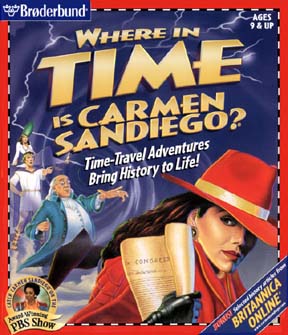
Carmen Sandiego's Great Chase Through Time is a 1997 edutainment point-and-click adventure game developed by Broderbund for Microsoft Windows and Macintosh devices. The game is a remake of the 1989 time-travel title Where in Time Is Carmen Sandiego?, making it the second Time video game in the Carmen Sandiego franchise. The game was strongly influenced by the short-lived PBS game show, Where in Time Is Carmen Sandiego?. The game was previewed at the 1997 Toy Fair in New York City. A demo version was included on the CD for Carmen Sandiego Word Detective and was available on the Carmen Sandiego website. After Broderbund was sold to The Learning Company, the game was re-released with the new title - Carmen Sandiego's Great Chase Through Time - but with minimal redesign.
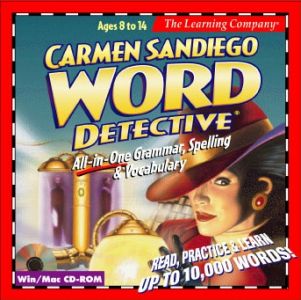
Carmen Sandiego Word Detective is a game in the Carmen Sandiego franchise which was released in 1997. The plot of the game sees Carmen Sandiego inventing a machine called the Babble-On Machine, and the player in the role of Agent 13, thwarting her plans by freeing all the other agents which have been captured by Carmen. The title is very similar in format to Carmen Sandiego Math Detective, which was released a year later.

Where in the World Is Carmen Sandiego? is a 1996 video game part of the Carmen Sandiego franchise. It was the third version of the game, after the 1985 original title of the same name and a 1992 Deluxe version of said game. The game's release coincided on the heels of the end of the PBS game show, and features QuickTime videos of Lynne Thigpen reprising her role as "The Chief". This was the last version of the game to follow the "classic" formula of the series, but much of the game, especially the "warrant" portion, was heavily redesigned. The Deluxe Edition released in 1998 added speech welcoming the player to each country and an "ACME Global Language Link-Up" satellite which quizzed the user on the local language. Players also received a spy watch and "an introduction to 12 foreign languages".

Carmen Sandiego: Junior Detective is a 1995 education game in the Carmen Sandiego franchise developed by Broderbund. Although not a version of Where in the World Is Carmen Sandiego? by name, it is essentially a simplified version of it for pre-readers. Allgame says the game "is geared for younger users, with only 14 cases to solve". The lead characters of the FOX animated series Where on Earth Is Carmen Sandiego?, Zack and Ivy, were included in the game, along with Stretch - "ACME's crime-tracking dog".
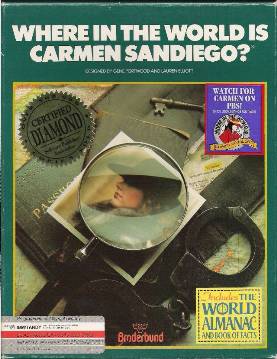
Where in the World Is Carmen Sandiego? is an educational video game released by Broderbund on April 23, 1985. It is the first product in the Carmen Sandiego franchise. The game was distributed with The World Almanac and Book of Facts, published by Pharos Books. An enhanced version of the game was released in 1989, which did not have the almanac-based copy protection and instead used disk-based copy protection. A deluxe version was released in 1990, and featured additional animation and a reworked interface from the original version. Some of the bonus features included digitized photos from National Geographic, over 3200 clues, music from the Smithsonian/Folkways Recordings, 20 villains, 60 countries, and 16 maps. CD-ROM versions for DOS and Macintosh were released in 1992, and a Windows version was released in 1994.

A Passion for Art: Renoir, Cezanne, Matisse, and Dr. Barnes is a 1995 interactive CD-ROM by Corbis.




















